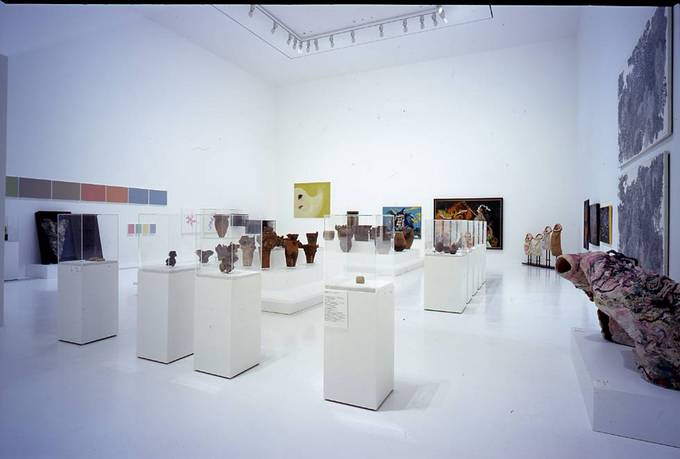The New Museology (Museum Studies)
On September 13, 2010, a symposium titled "New Museology: Drawing Synergies between Cultural Heritage and Contemporary Cultures," jointly organized by the Japan Foundation and the Sainsbury Institute for the Study of Japanese Arts and Cultures, was held at Akiba Hall in Tokyo. Here, Nicole Coolidge Rousmaniere, Director of the Sainsbury Institute for the Study of Japanese Arts and Culture, who chaired the symposium, and one of the panelists Junichi Shioda, Executive Art Director and Chief Curator of the Aomori Museum of Art, discuss their views on the concept of the new museology which integrates cultural heritage with contemporary culture (moderator: Hideki Hara, Director, Europe, Middle East and Africa Section, Japanese Studies and Intellectual Exchange Department)
Manga Display Popular at British Museum Dogu Exhibition
──You organized "The power of dogu: ceramic figures from ancient Japan," a very successful exhibition of ancient ceramic figures at the British Museum in 2009. Moreover, one of the reasons for this success was the use of Yukinobu Hoshino's manga comics. We applaud the bold decision by the British Museum to adopt this novel approach. Perhaps you would tell us how you came up with this idea.
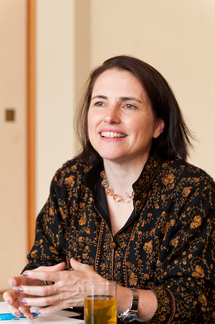 ROUSMANIERE: The British Museum put together the dogu exhibition because we wanted to present an introduction to ancient Japan in a form accessible to many people. Director Neil MacGregor believes in communicating the appeal of different cultures and their points of interest to the public. Recently we broadcast a 10-month program on BBC Radio 4 called A History of the World in 100 Objects, which looked at history through a selection of 100 objects from the British Museum (program available on the BBC website). It was an unusual project for radio, because the objects could not be shown, but we counted on that very fact to stimulate peoples' interest and encourage them to visit the museum.
ROUSMANIERE: The British Museum put together the dogu exhibition because we wanted to present an introduction to ancient Japan in a form accessible to many people. Director Neil MacGregor believes in communicating the appeal of different cultures and their points of interest to the public. Recently we broadcast a 10-month program on BBC Radio 4 called A History of the World in 100 Objects, which looked at history through a selection of 100 objects from the British Museum (program available on the BBC website). It was an unusual project for radio, because the objects could not be shown, but we counted on that very fact to stimulate peoples' interest and encourage them to visit the museum.
Of these 100 objects, four were from Japan. The first was a cylindrical pot from the Initial Jomon period (7000-4000 BC) that had been acquired in the early 19th century by Philipp Franz von Siebold, a German doctor and naturalist who traveled to Japan. The pot is now in the possession of the British Museum. It was a characteristically apt choice by our director, because this archaeological artifact also has links with the modern era. The pot was found in the Tohoku region of northeast Japan in the late Edo period, and ended up being used as a water jug by a tea ceremony master, who covered it in lacquer and lined it with gold foil. In a sense, every artifact is alive, with its own history and its own story. That is what makes each one so precious.
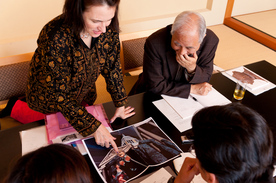 Four years ago, I organized an exhibition, Crafting Beauty in Modern Japan, to present the works of Japan's living national treasures. At the same time, another exhibition, The First Emperor: China's Terracotta Army, was being held on another floor. While viewing it, I began to feel curious about the figurative art of ancient Japan. My choice of exhibiting Jomon dogu rather than pottery was intended to stimulate visitors with the imaginative world of ancient Japan.
Four years ago, I organized an exhibition, Crafting Beauty in Modern Japan, to present the works of Japan's living national treasures. At the same time, another exhibition, The First Emperor: China's Terracotta Army, was being held on another floor. While viewing it, I began to feel curious about the figurative art of ancient Japan. My choice of exhibiting Jomon dogu rather than pottery was intended to stimulate visitors with the imaginative world of ancient Japan.
At the same time, I pondered the meaning that dogu have for contemporary Japanese people. There is a huge dogu figure over the entrance to the Kizukuri railway station in Aomori prefecture, and people enter the station through the legs of the figure. I included a photograph of the station in the exhibition. My intention was to show that it was not simply a whimsical representation, but that to the local people the dogu were gods who protect travelers.
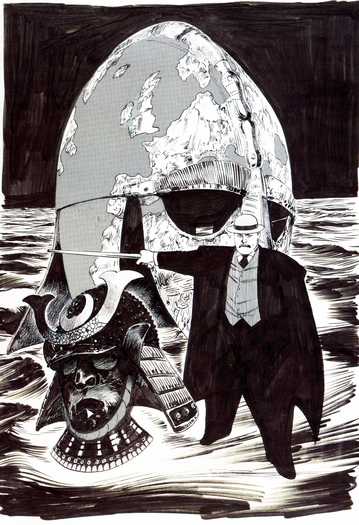
Yukinobu Hoshino: Professor Munakata's British Museum Adventure
To foreigners, it is difficult to imagine a connection between dogu and contemporary society. But dogu often appear in manga, so we thought of using manga to promote understanding of dogu. We asked the artist Yukinobu Hoshino, who often draws manga on themes from ancient history, to exhibit his works along with the dogu exhibition. The show was a big hit. We simply gave Mr. Hoshino some information about the exhibition, and let him decide what to draw. He has created a manga serial about the British Museum, which is out in paperback in Japanese, with an English translation to be published in April of next year.
Thrilling Maze next to Sannai-Maruyama Site
──The Aomori Museum where you are Art Director is located beside the Sannai-Maruyama ruins. Was the museum designed with this location in mind?
SHIODA: The area next to the Sannai-Maruyama site was originally an athletics field. However, when they started to build a new baseball field in 1992, a remarkable number of artifacts were unearthed during the construction. Full-scale archaeological excavations revealed the presence of a huge settlement of the Middle Jomon period, dating back about 5000 years. Meanwhile, the prefectural government had grand plans to turn the park into a cultural arts complex of museums and theatres. In the end, this plan was greatly scaled down due to budget restrictions and so on, and only the museum was constructed. Although it is a little distance from downtown Aomori city, the Museum's location has a unique magnetism arising from its links with prehistoric time. I feel that the decision to build on this site has added to the enjoyment of the museum experience in many ways.
 The museum is notable for its architectural design. In an archaeological excavation, first you dig a trench, and then gradually excavate the layers of earth. Architect Jun Aoki was inspired by the trenches at the Sannai Maruyama site, and submitted a design in the architectural competition, in which the exhibition space comprises a white cube that sits on top of a trench dug out of the earth. There is nothing like it anywhere else in the world, and could not be imagined anywhere else but at the Sannai-Maruyama site.
The museum is notable for its architectural design. In an archaeological excavation, first you dig a trench, and then gradually excavate the layers of earth. Architect Jun Aoki was inspired by the trenches at the Sannai Maruyama site, and submitted a design in the architectural competition, in which the exhibition space comprises a white cube that sits on top of a trench dug out of the earth. There is nothing like it anywhere else in the world, and could not be imagined anywhere else but at the Sannai-Maruyama site.
Ultimately, this plan was chosen, and the completed building is a wonderful piece of architecture in which earthen walls and floors are interspaced with white cubic spaces. Since all of the exhibition halls are underground, it is like a huge maze, making it easy to lose your bearings, but it will stimulate your imagination tremendously.
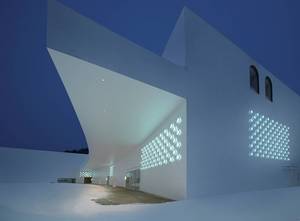 The first objects displayed in the 1,500 square meter permanent exhibition space, were the famous flat, cross-shaped dogu that has been designated as Important Cultural Properties, as well as pottery and stone tools, all of which were unearthed from the Sannai-Maruyama site. These artifacts are the property of the "Jomon Jiyukan" Museum adjoining the Art Museum. Beyond the Jomon display are exhibits that continue the local theme by featuring artists who grew up in Aomori, such as Shiko Munakata (woodblock printmaker), Shuji Terayama (dramatist and writer), Neo-dada artist Tetsuya Kudo, and the young artist Yoshitomo Nara, with a separate room devoted to each. The razor-edged creativity of these exceptional artists may be a product of the harsh climate of this region located at the northernmost tip of Honshu Island. So the Sannai-Maruyama site is really the starting point for all of the museum's activities.
The first objects displayed in the 1,500 square meter permanent exhibition space, were the famous flat, cross-shaped dogu that has been designated as Important Cultural Properties, as well as pottery and stone tools, all of which were unearthed from the Sannai-Maruyama site. These artifacts are the property of the "Jomon Jiyukan" Museum adjoining the Art Museum. Beyond the Jomon display are exhibits that continue the local theme by featuring artists who grew up in Aomori, such as Shiko Munakata (woodblock printmaker), Shuji Terayama (dramatist and writer), Neo-dada artist Tetsuya Kudo, and the young artist Yoshitomo Nara, with a separate room devoted to each. The razor-edged creativity of these exceptional artists may be a product of the harsh climate of this region located at the northernmost tip of Honshu Island. So the Sannai-Maruyama site is really the starting point for all of the museum's activities.
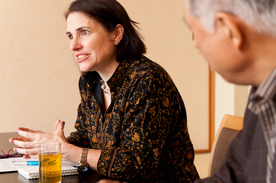 ROUSMANIERE: I like the Aomori Museum of Art very much. Mr. Shioda has described it as a white cube, and when I first saw it, during a heavy snowfall in January, the entire landscape around the museum was white except for a green symbol resembling a Christmas tree. The museum disappeared into the surroundings, or I might say that the museum seemed to emerge from the landscape, and I felt that the building and its locale were perfectly matched. I was extremely inspired by it.
ROUSMANIERE: I like the Aomori Museum of Art very much. Mr. Shioda has described it as a white cube, and when I first saw it, during a heavy snowfall in January, the entire landscape around the museum was white except for a green symbol resembling a Christmas tree. The museum disappeared into the surroundings, or I might say that the museum seemed to emerge from the landscape, and I felt that the building and its locale were perfectly matched. I was extremely inspired by it.
The British Museum is very different. The building looks like a hotel or bank, and differs from traditional British architecture as well. It is classical in style, evoking the origins of Western civilization in Greece and Rome.
The British Museum was constructed in 1753, based on the collection of Sir Hans Sloane. From the beginning, the museum has exhibited art works from around the world including objects from Japan. It could be said that the world was in the hands of the British Empire and that the entire world could be glimpsed at the British Museum. Conversely, they did not have many objects of domestic origin, but measures have been taken to remedy this situation since about 100 years ago, and now there is an extensive collection of archaeological materials from local sites as well.
Many of our visitors are from other countries, and only about 40 percent have English as their first language. It is a challenge to present exhibits in a way that will appeal to such a diverse audience. One thing that all visitors have in common is that they are living in the contemporary world. Therefore, our present approach is to use the contemporary as a means of understanding various cultures.
With this in mind, we have been adding outstanding examples of contemporary art to our collection. A recent addition is a work of Kaga zogan (metal inlay craft) by Mamoru Nakagawa, a living national treasure of Japan. Through these examples of contemporary works, we can further our understanding of the arts and crafts of past ages, such as yoroi (Japanese armor), in which the techniques of kaga zogan were used.
The manga exhibition was a wonderful new kind of approach that made communication possible without the need for words. In fact, it attracted attention within Britain as well, and was covered by The Economist and The Times. Even though we may not be able to fully understand Roman sculpture, it is important to look at it in a form we can understand, and thus to gradually develop a sense of familiarity with history. So the direction of the approach is not moving from local subjects to broader global concerns, but rather a "glocal" approach, starting out with a global point of view and moving to local interests.
Jomon Exhibit Gives Museum Broader Perspective
──The artists featured at the Aomori Museum of Art were all born in Aomori Prefecture, from which they made their way, first to the cities, and then throughout the world, and finally returning home, in a sense, to the Aomori Museum of Art.
ROUSMANIERE: In other countries, people do not necessarily have a direct connection to the archaeology of the area in which they live. In the UK, for example, many people today trace their roots across national borders to various other countries. Therefore archaeological excavations, although interesting in themselves, don't always carry the emotional aspect of connecting with one's ancestors.
But to the Japanese, archaeological materials are closely linked to their identity. Although it is not clear whether or not the present-day Japanese are actually descendants of the Jomon people, there is a sense of continuity with them. I feel that this is strongly related to the Japanese character.
In Aomori, people care deeply about the Jomon sites, even if they don't have a particularly deep knowledge of archeology, and there is a general sense of familiarity with their heritage. Jomon fragments are sometimes found by chance by people digging in their yards. They are really living side-by-side with history. That is why art museums and museums are not separated in Aomori. I feel that this is truly unique. By exhibiting historical artifacts as works of art, they are suggesting new definitions for these objects.
SHIODA: Yes. Initially, the Jomon Jiyukan museum at Sannai-Maruyama site did not have adequate facilities to exhibit very valuable artifacts such as the flat dogu, which have been designated as Important Cultural Properties. In 2010, a fully-equipped new exhibition hall, the Sanmaru Museum, was constructed in the Jomon Jiyukan, and the Important Cultural Properties have been transferred there. However, we continue to display Jomon pottery, stone tools, bone tools, and dogu at our museum as well. They are at the core of our permanent exhibit, and continue to serve as our starting point, allowing people to reflect on what art is, and what figurative expression is, from the perspective of both time and space. The approach has great significance for the people of Aomori and I think it provides an important advantage not found in other Japanese museums.
ROUSMANIERE: In one respect this is what the new museology is about. It means breaking down the academic boundaries of archaeology and art, museums and art museums, to propose new ways of exhibiting items and utilizing exhibition spaces.
Art Museum Brings Different Objects Together
──The symposium held in October emphasized the importance of "telling a story" in addition to the idea of "perspective". I have always felt that the fundamental role of museums and art museums is to display objects in a way that broadens perceptions of time and space, and to stimulate the imagination as much as possible.
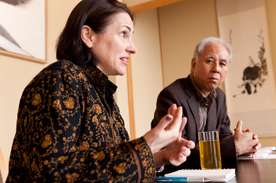 ROUSMANIERE: What you say is true. The Japan Gallery of the British Museum opened in April of 1990, with a permanent exhibition installed in October 2006. It is now known as the "Mitsubishi Corporation Japan Galleries," and the display has been changed along with the name. The renewal was inspired by the creation of the Interpretation Unit at the British Museum, which was set up to promote an interpretive approach to permanent exhibitions such as the Japan Gallery.
ROUSMANIERE: What you say is true. The Japan Gallery of the British Museum opened in April of 1990, with a permanent exhibition installed in October 2006. It is now known as the "Mitsubishi Corporation Japan Galleries," and the display has been changed along with the name. The renewal was inspired by the creation of the Interpretation Unit at the British Museum, which was set up to promote an interpretive approach to permanent exhibitions such as the Japan Gallery.
Interpretation and education are different concepts. While education involves the presentation of works of art and artifacts to viewers, interpretation concerns itself with aiding the understanding of the objects. New interpretive panels must be written for each exhibit, and the curators in charge of the permanent exhibitions give careful thought to the wording of the panels and the order in which they are displayed. The Interpretation Unit then checks and gives final approval to the contents. The reason we go to so much trouble is that a survey conducted by the British Museum found that many people would read the explanatory panels at special exhibits where they had paid an entrance fee, but did not read those at the free-of-charge permanent exhibitions. Therefore we decided to improve the interpretive panels for the permanent exhibits.
The Interpretation Unit was established in order to develop an approach in which the displays tell a story to the viewer. Objects are not simply displayed in chronological order, but have been arranged to tell a narrative; the Japan Gallery's permanent exhibition features a total of 43 stories. For each story, a key object is chosen, in front of which a pebble is placed. Short, color-coded sentences describe the history of the object, the story it tells, and its significance. Viewers first look at the object, and if they are interested, go on to read the labels and panels. The idea is to stimulate interest through the stories told on the explanatory panels. Key objects are changed about four times every year. The theme remains more or less the same, but the stories change. This approach has met with success.
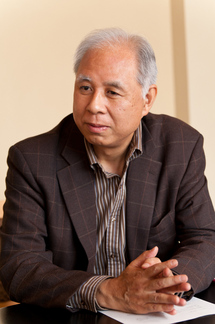 SHIODA: In other words, the new museology is an approach which combines objects from different categories. I think that one of the first approaches of this kind was the Primitivism in 20th Century Art exhibition held at the MoMA Museum in New York in 1984. This exhibition was a revolutionary attempt to show the influence of non-European tribal art from Africa and Oceania on major artists of the 20th century such as Picasso. Objects previously considered as anthropological and ethnographical artifacts were displayed together with works of fine art.
SHIODA: In other words, the new museology is an approach which combines objects from different categories. I think that one of the first approaches of this kind was the Primitivism in 20th Century Art exhibition held at the MoMA Museum in New York in 1984. This exhibition was a revolutionary attempt to show the influence of non-European tribal art from Africa and Oceania on major artists of the 20th century such as Picasso. Objects previously considered as anthropological and ethnographical artifacts were displayed together with works of fine art.
I had this kind of precedent in mind while planning the exhibition Naivety in Art for the Setagaya Art Museum when it opened in 1986. The Setagaya Art Museum had a collection of paintings by French Naive artists such as Henry Rousseau, Andre Bauchant, and Camille Bombois. But, in order to more broadly explore the idea of naïve art, we included Naive art works from Europe and America, contemporary Neo-expressionist art of the 1980s, primitive and ancient art such as dogu and haniwa, art of the Orient, and folk art works such as masks and sculptures from Africa and Oceania. Furthermore, we added pictures drawn by children and art created by people with mental handicaps, so that it ended up being a rather large-scale exhibition.
Such experiences have made me conscious of the creative possibilities that arise in a museum environment when different kinds of objects are brought together across the boundaries of time and style. The Aomori Museum of Art, with its proximity to the Sannai-Maruyama site, is very much suited to this approach.
Strong Sense of Identity in Japan's Local Regions
ROUSMANIERE: Each region's cultural identity is just as important as its locality.
SHIODA: That's right. When trying to define the identity of the people of Aomori, particularly in the field of art, we came up with the keyword "Jomon," which has a strong impact and is easy to understand. We hope to create a deeper and wider understanding of our culture through this keyword.
ROUSMANIERE: There is the fact that in Japan, the concept of the state became widely accepted only in the 19th century. In the Edo period, the term kuni (country) was closer in meaning to the modern ken (prefecture). Each local region had its own separate identity; for example, laws were slightly different in Nanbu and Tsugaru, even though they were next to each other. It is my impression that even now, Japan retains these local identities.
──Visitors can rediscover their own local culture through viewing the displays in the museum. It seems to me that such an experience has something in common with the new museology movement.
ROUSMANIERE: When you are searching the Internet or taking classes, you are just sitting there, passively receiving information, but if you want to really learn, you have to go out and discover things for yourself. Even if you have to force yourself, you should go to art museums and archaeological sites, see the actual objects for yourself, touch them, and receive your own impression of them, and in doing so the knowledge will become a part of you. You will rediscover your cultural identity.
SHIODA: In today's world everything has become so specialized. You may know a lot about your own field, but almost nothing about what the person next to you is doing. The original function of art museums and museums was to collect and classify objects, but perhaps it is time to regroup and take a more generalized approach.
ROUSMANIERE: I agree with you. That is also why Japan should be less conservative and be less afraid of taking risks. In that sense, I feel that the Aomori Museum of Art is taking risks of the right sort.
SHIODA: In our second special exhibition after opening, entitled "Affinity of the Jomon and the Contemporary," we displayed archaeological artifacts alongside contemporary art works in order to reflect on the links between these two eras. I know that the British Museum has incorporated installations by contemporary artists into their Egypt exhibition. It is an approach we should consider as well, exhibiting Jomon pottery together with one of Antony Gormley's installations, for example.
ROUSMANIERE: That would be very interesting.
SHIODA: I believe that in Aomori prefecture, artistic expression had its beginnings in Jomon culture. There are many artists, in Japan and around the world, who are interested in going back to the origins of artistic expression. I would like to have those artists come to Aomori and engage in the creation of art works here. The Affinity of the Jomon and the Contemporary exhibition was an experiment, but it should not be a one-time-only event; we need more exhibitions along the same lines in the future.
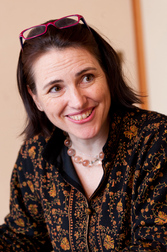 Nicole Coolidge Rousmaniere
Nicole Coolidge Rousmaniere
Director of the Sainsbury Institute for the Study of Japanese Arts and Culture
The Sainsbury Institute for the Study of Japanese Arts and Culture was established in Norwich City in 1999 in order to promote research on Japanese arts and material culture, and to help link international research in the field. For the past few years Rousmaniere has also held the post of Visiting Professor of Cultural Resource Studies at the University of Tokyo. She has planned and organized several exhibits on Japanese art at the British Museum, including Crafting Beauty in Modern Japan in 2007 and The Power of Dogu in 2009.
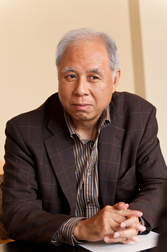 Junichi Shioda
Junichi Shioda
Executive Art Director and Chief Curator of the Aomori Museum of Art
Before assuming his present position Shioda worked as Curator at the Tochigi Prefectural Museum and the Setagaya Art Museum, Head Curator of the Museum of Contemporary Art Tokyo, and Vice Director of the Tokyo Metropolitan Teien Art Museum. His areas of specialization are contemporary art and museum management studies. In 1999 he served as Commissioner for the Japanese Pavilion at the Venice Biennale. He has directed numerous exhibitions of British art including David Nash (1984, Tochigi Prefectural Museum), St. Ives (1989, Setagaya Art Museum and others), British Art Now: A Subjective View (1990, Setagaya Art Museum and others), REAL/LIFE-New British Art (1998, Museum of Contemporary Art Tokyo and others), Alfred Wallis (2007, Tokyo Metropolitan Teien Art Museum and others). He is the author of Igirisu bijutsu no fukei (The landscape of British Art), Brucke, 2007.
Related Events
Keywords
Back Issues
- 2023.12. 7 Movie Theaters aroun…
- 2023.6.16 The 49th Japan Found…
- 2023.4.24 The 49th Japan Found…
- 2022.12.27 Living Together with…
- 2022.12.27 Living Together with…
- 2022.8.12 Inner Diversity <…
- 2022.3.31 The 48th Japan Found…
- 2022.3.29 Beyond Disasters - T…
- 2021.11.29 Crossing Borders, En…
- 2021.4.13 Crossing Borders, En…


